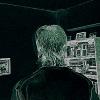The code for generating the map is very slap-dash, just thrown together in a Qt application I was using to generate 2D noise maps.
Here's the noise method first. This is heavily based on Sean O'Neil's Sandbox project, just reformatted to my own taste and explicitly three dimensional:
class Noise
{
public:
explicit Noise(unsigned int seed);
float noise(float f[3]) const;
protected:
float lattice(int ix, float fx, int iy=0, float fy=0, int iz=0, float fz=0, int iw=0, float fw=0) const;
unsigned char perm[256];
float buffer[256][3];
};
Noise::Noise(unsigned int seed)
{
std::srand(seed);
for(int i = 0; i < 256; ++i)
{
perm[i] = i;
for(int j = 0; j < 3; ++j)
{
buffer[i][j] = (float)random(-0.5, 0.5);
}
float magnitude = 0;
for(int j = 0; j < 3; ++j)
{
magnitude += buffer[i][j] * buffer[i][j];
}
magnitude = 1 / sqrtf(magnitude);
for(int j = 0; j < 3; ++j)
{
buffer[i][j] *= magnitude;
}
}
for(int i = 0; i < 256; ++i)
{
int j = static_cast<int>(random(0, 255));
std::swap(perm[i], perm[j]);
}
}
float Noise::noise(float f[3]) const
{
int n[3];
float r[3];
float w[3];
for(int i = 0; i < 3; ++i)
{
n[i] = floor(f[i]);
r[i] = f[i] - n[i];
w[i] = cubic(r[i]);
}
float value = lerp(lerp(lerp(lattice(n[0], r[0], n[1], r[1], n[2], r[2]), lattice(n[0]+1, r[0]-1, n[1], r[1], n[2], r[2]), w[0]),
lerp(lattice(n[0], r[0], n[1]+1, r[1]-1, n[2], r[2]), lattice(n[0]+1, r[0]-1, n[1]+1, r[1]-1, n[2], r[2]), w[0]),
w[1]),
lerp(lerp(lattice(n[0], r[0], n[1], r[1], n[2]+1, r[2]-1), lattice(n[0]+1, r[0]-1, n[1], r[1], n[2]+1, r[2]-1), w[0]),
lerp(lattice(n[0], r[0], n[1]+1, r[1]-1, n[2]+1, r[2]-1), lattice(n[0]+1, r[0]-1, n[1]+1, r[1]-1, n[2]+1, r[2]-1), w[0]),
w[1]),
w[2]);
return clamp(value * 2.0f, -0.99999f, 0.99999f);
}
float Noise::lattice(int ix, float fx, int iy, float fy, int iz, float fz, int iw, float fw) const
{
int n[4] = { ix, iy, iz, iw };
float f[4] = { fx, fy, fz, fw };
int index = 0;
for(int i = 0; i < 3; ++i)
{
index = perm[(index + n[i]) & 0xFF];
}
float value = 0;
for(int i = 0; i < 3; ++i)
{
value += buffer[index][i] * f[i];
}
return value;
}
In my temporary application, I'm currently generating the Back and Right faces. Essentially I do this (dim is a global dimension of each side of each face of the cube map).
QImage generate(Face face, Noise &noise)
{
QImage image(dim, dim, QImage::Format_ARGB32);
for(int iy = 0; iy < dim; ++iy)
{
for(int ix = 0; ix < dim; ++ix)
{
float v[3];
createDirection(face, v, ix, iy);
float n = generateNoise(noise, v);
image.setPixel(ix, iy, color(n));
}
}
return image;
}
float generateNoise(Noise &noise, float v[3])
{
float n = noise.noise(v);
return (n + 1.0f) / 2.0f;
void createDirection(Face face, float *v, int ix, int iy)
{
float x = static_cast<float>(ix);
float y = static_cast<float>(iy);
QVector3D vec;
switch(face)
{
case Face::Back: vec = QVector3D(x, y, 1); break;
case Face::Right: vec = QVector3D(1, y, x); break;
default: break;
}
float hd = static_cast<float>(dim) / 2.0f;
QVector3D centroid(hd, hd, hd);
QVector3D to = vec - centroid;
to = to.normalized();
v[0] = to.x();
v[1] = to.y();
v[2] = to.z();
}
The outputs are nice, smooth noise maps, but they refuse to tile.
Back:
[attachment=33011:back.png]
Right:
[attachment=33012:right.png]
I'm not sure if I am getting the 3D noise function wrong, or if there is some mistake in the way I am mapping pixels to directional vectors, or what the problem is. I was under the impression that as I walked around the noise functions with directional vectors around a sphere, I'd get tiling happening.
Appreciate this is a big ask, but can anyone help me out here? Thanks in advance.








